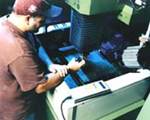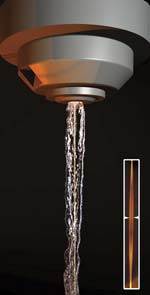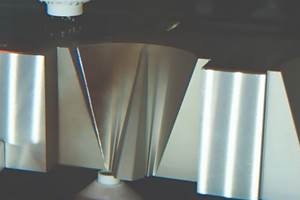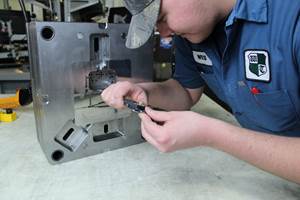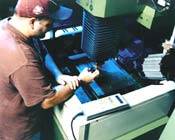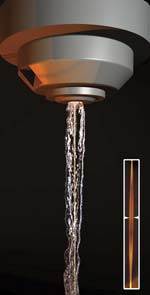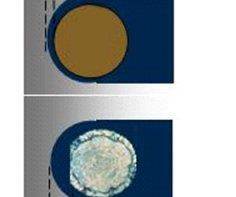Maintaining a Wire EDM Machine
To achieve the ultimate capability and level of productivity from your wire EDM on a consistent, repeatable and reliable basis, regular maintenance is a required task.
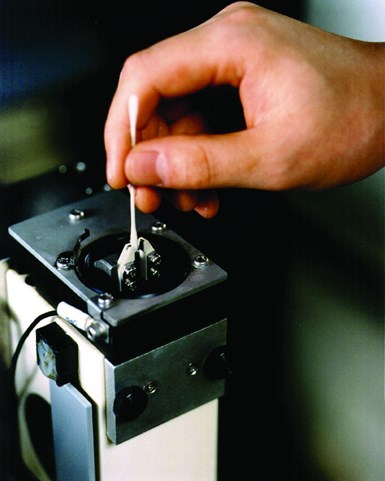
Some wire machines can be easily hand cleaned with a cotton swab as part of routine wire EDM maintenance. Photo Credit: Makino
Over the past three decades, wire electrical discharge machining (EDM) has advanced and transformed into an everyday, commonly relied upon process. The capabilities and performance in today’s wire EDM machines continue to develop and improve in the three main machining characteristics: speed, accuracy and surface finish.
Gains in machining speed have reduced overall process cycle times while also delivering sustained and repeatable dimensional accuracy. These wire EDM machines can automatically thread wires of less than 0.001 inch in diameter through holes barely larger than a human hair. And they can produce mirror-like surface finishes with micro-machined part details so minute that they require a microscope to view with the human eye.
In order to accomplish this capability and level of productivity on a consistent, repeatable and reliable basis, these modern technology marvels must be maintained on a regular schedule, according to their manufacturers’ recommendations.
Maintenance Intensive
A wire EDM machine may be one of the most maintenance intensive pieces of equipment in the machine shop environment. This should not be a concern, as this does not downplay any of the machine’s productive capability nor indicate any excessive downtime. It does, however, elevate the importance of a disciplined preventive maintenance schedule.
For example, a highly-tuned automobile racing engine will not produce at its rated horsepower, torque or performance levels without regular care and scheduled maintenance. A wire EDM machine will behave much in the same manner, and will not perform to the speeds, finishes and accuracies they are renowned for if not properly maintained.
The main difference between wire EDM and other traditional machining processes in regard to maintenance is that it must be done as a proactive and preventive measure. Adherence to strict maintenance at recommended intervals is crucial to the process performance.
Due to the electro-mechanical nature of wire EDM machines, there are several items in normal operation that routinely wear and require cleaning and/or replacement. If certain machine components are not properly cared for, machining speeds and accuracies will rapidly decay.
The most important reason to properly schedule and perform this routine wire EDM maintenance is to ensure consistent and repeatable machining results for the aforementioned machine traits of speed, accuracy and surface finish. This level of maintenance also prevents machine failure and unexpected machine downtime.
There are several wire EDM machine tool manufacturers, and there are some significant differences in the machine design of each. But the importance and type of basic items that need to be maintained on all wire EDMs are very similar. When planning and scheduling wire EDM machine maintenance, required actions can be grouped into short interval and long interval items.
Short Interval Items
Short interval items vary in occurrence from weekly to monthly.
- Automatic Wire Threading System. The automatic wire threading (AWT) system performs the threading of the wire via a water jet column. It is the single most important automated feature on a wire EDM machine. Utilization of an AWT system will extend the unattended operation of the machine. AWT units typically require cleaning and alignment checks of mechanical components and sensors to promote reliable operation.
- Power Contacts. These two contacts deliver the electrical cutting power to the wire. These contacts — both on the upper and lower machine heads — will erode over time, resulting in a significant decrease of machining speed. They require a simple indexing and cleaning, and eventual replacement.
- Belts and Rollers. These items make up the wire transport system. They require either cleaning indexing or replacement to prevent wire slippage and/or wire tension problems which can result in part inaccuracies.
- Brake/Clutch Roller. This roller is the most critical item in the wire transport system. Its function is to create and control the proper tensioning of the wire. If wire tensions are not held to within certain parameters, workpiece inaccuracies, excessive wire breaks and excessive wire lines on the workpiece may result. This unit is typically maintained with the aid of an OEM-supplied procedure or calibration cycle.
- Wire Guides (2). These guides — either diamond or sapphire — are located in both the upper and lower machine heads. They are used to align and locate the wire within the machine. The guides are the most important item within the machine because they deliver and transfer the machine tool accuracy into the workpiece. They require cleaning to prevent misfeeding, clogging, part inaccuracies and failure.
- Wire Alignment. This procedure is typically required after wire guide cleaning with the aid of an OEM-supplied jig or fixture, and is performed to calibrate and align the wire within the machine for verticality. If the wire is not properly aligned for verticality, machined results will contain tapers and positional part locations will be inaccurate.
- Wire Collection Box. The wire is only used once within the machine, and will accumulate in a box or bin that will need to be emptied periodically. The spent or used wire should be routinely checked and emptied per manufacturer recommendations. The spent material can typically be recycled through an industrial materials scrap recycler.
- Machine Seals. Many machine designs require cleaning of a door and tank seal to ensure seal integrity and longevity. Seals will need to be replaced once they become degraded beyond their service life and can no longer sufficiently prevent or control water leakage.
- General Cleaning. With the intricate wire EDM process, debris is typically scattered evenly throughout the work tank. Over time, this debris can accumulate and build up into a hard scale that is difficult to clean. Scheduling a monthly machine cleaning using a standard cleaner will prevent large buildups of debris. Less overall time will be required the more frequent the cleanings. Generally, the cleaner a machine is kept, the less likelihood there is for unsuspected problems to arise. This also may extend the life of some long interval consumable items.
Long Interval Items
Long interval items vary from bi-monthly to yearly.
- Machine Filters. Replacement of the main water filters will be required and should be performed as needed. Most machines typically generate an alarm when the filters are depleted. Replacement intervals are purely dictated by the type of work, workpiece material and thickness, and applications being performed. Many machines also contain a safety filter for the AWT system that will need replacing periodically (six to 12 months). The filtration system on a wire EDM is fundamentally necessary because it controls the amount and size of particles/debris that can exist and be circulated through the flushing system during machining. If this debris is excessive and of a large particulate size, machining will be very unstable and inefficient.
- De-ionization Resin. This is a special resin that is used to control the conductivity of the water within the machine. If the conductivity or resistivity of the water is not controlled and sustained at a certain level that the machine requires, machining will become very unstable, and final results will be inaccurate. The de-ionizing (DI) resin is replaced when needed. Most machines typically generate an alarm when the resin is depleted. There also is a conductivity/resistivity probe that requires cleaning to ensure proper level readings.
- Water Level. Over time, the water level in the machine reservoir will become low from evaporation and will need to be replenished. The quality of the incoming water (tap water is typically used) can affect the life of the DI-resin.
- Belts, Rollers and Pulleys. Certain machine designs require periodic replacement of some belts, rubber rollers and pulleys. Replacement may be required due to physical wear of the component or from wear of replaceable bearings. It is very important that these items be maintained, checked and/or replaced by specific procedures and intervals suggested by your machine tool manufacturer. Failure to keep these items within operational specifications will result in part inaccuracies and machine downtime.
- Wire Chopper. Some machines contain a wire chopping unit that cuts the used or spent wire into small pieces. Maintenance on this unit will include the sharpening or replacement of cutting blades and dies. The results of allowing these cutting edges to become excessively dull will lead to workpiece inaccuracies, excessive wire lines on the workpiece and machine downtime.
- Cabinet Filters. Some machine designs require the changing or cleaning of an air filter element. Such filters are commonly found on intake fans of the electrical/generator cabinets and water chiller units. These filters should be inspected, cleaned and replaced at regular intervals specified by the OEM. If these filters become excessively clogged, air flow will be restricted, which will lead to overheating and failure of the equipment.
- Machine Seals. Due to specific seal designs, some seals and/or gaskets may require a yearly replacement to ensure proper machine operation. The seals/gaskets that typically require the most attention are the work tank door gasket and the lower arm tank seal plate. Proper maintenance and care of the lower arm sliding seal plate is especially important because as this seal wears and friction increases, machining accuracies also may be degraded.
- Machine Floats. Most manufacturers recommend a yearly inspection and cleaning of machine operational and safety float switches. If these floats become excessively dirty, their operation may fail, resulting in damaged machine electrical components and water spillage.
- Water Reservoir. The quality level of the water within the machine can become degraded over time and heavy sediments also can build up in the water holding tanks. Contaminants from cleaning agents also can change the pH levels of the water, all of which can affect the performance of the machine. Most wire EDM manufacturers recommend that the water be drained and the water reservoir cleaned yearly. Insufficiently monitoring and maintaining the reservoir system may result in excessive machine corrosion, sedimentary buildup and machine component/pump failure.
- Machine Lubrication. Check with your machine’s OEM on recommended intervals and access points for machine lubrication. The most common items that require attention are the ball screws and linear guide way systems. Be sure to use the proper lubricants that are specified by the OEM. Improper lubrication of the machine will lead to workpiece inaccuracies and the eventual replacement of costly machine mechanical components.
General Cleaning Importance
Good cleaning habits and care of a wire EDM machine is highly recommended. Regular and systematic cleaning of the machine also can extend the life of some consumable items.
Care should be taken when selecting a cleaner. It is recommended that a general, all-purpose household cleaner/degreaser be used for general cleaning. A mild, watered-down solution of acid (typical EDM acid cleaners are phosphoric acid based) is used for the cleaning of more heavily soiled machine components.
When using any cleaner, it is best to apply the cleaner to a rag and not directly spray cleaners into the machine. This will result in using less cleaner as well as controlling the contamination of the water reservoir.
Do not allow caustic or acidic cleaners to sit on some surfaces too long as they may etch, bleach or damage surfaces. And avoid getting cleaners on attachment points where power cables connect to the machine heads, as cleaners can act like a corrosive agent and degrade the power cables.
After cleaning, be sure to wash and rinse cleaned surfaces with water. This will ensure that the cleaners are properly removed prior to operation.
Keep in mind, the underlying concept and operating strategy for wire EDM is to maximize the unattended machining time. With a properly maintained wire EDM machine, the goals of maximizing machine up-time and greater overall process efficiency can be more easily achieved and realized.
Due to machine design differences, the type and time intervals of machine maintenance can vary. It is highly recommended to check with and follow the maintenance specifications, intervals and procedures supplied by your machine OEM. If maintenance requirements, procedures or intervals are in question, contact your OEM or refer to your machine’s maintenance manual for more information.
Related Content
Soft Wired: Cutting High Taper Angles with Wire EDM
Examine the wire’s properties to determine the right one for achieving the best cut.
Read MoreMachine Monitoring Platform Improves Machine Utilization, On-Time Delivery
Using data from a machine monitoring platform, Westminster Tool added almost 75 hours of capacity per week by shortening warmups and starting CNC and EDM machines sooner.
Read MoreIntegrated CAD/CAM Streamlines Electrode Manufacture, Improves Quality
A focus on electrode design and automation helps toolroom improve efficiency, reduce tooling costs and deliver higher quality products.
Read MoreHow to Improve Your Current Efficiency Rate
An alternative approach to taking on more EDM-intensive work when technology and personnel investment is not an option.
Read MoreRead Next
Burning Bright
EDM experts reveal that trends in increased automation combined with unattended machining result in better accuracy and surface finishes in wire and diesinking EDM applications.
Read MoreWear Parts and Consumables: The Keys to Maximizing Your EDM
Mold shops need to pay attention to the potential impact wear parts and consumables can have on their overall production.
Read MoreMachining Variables Influencing High-Performance Wire EDM
While EDM speeds today are impressive, there are a number of machining variables that influence the machining speed of the wire EDM.
Read More
